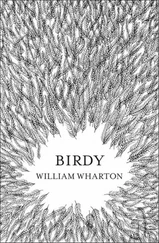One bird has an infected joint, where the toe joins the leg. She cleans this thoroughly, gently, expertly touching, feeling for swelling, and puts both alcohol and antiseptic in the sore spot.
As she finishes with a pigeon, she deftly reaches into each of about ten little bags she has lined up close to her thigh. She chooses individual grains, as if they’re vitamin pills, and feeds them, one at a time, to the bird on which she’s just worked. The pigeon, meanwhile, is flutting out its feathers, doing a quick little inspection with its beak, checking any repair work that’s been done.
The pigeon takes the grains from her hand as she offers them, then she gracefully swings away the pigeon on which she’s been working, gently off her finger. They usually fly up, circle a few times, then land on the statue of Diderot for a quick rump-thumping crap. The favorite places seem to be the pen in his hand, his hand itself, and his head.
There are pigeons all over Diderot. He has even more pigeons on him than the old lady, but then he’s about ten times bigger. He has a patina of white pigeon shit over the dark green patina of his bronze to show for it, too.
I watch through about five or six pigeons. I’m too fascinated to even think about getting back to work. I’ve never seen anything like this. I had canaries when I was in high school and I loved to hear them sing. But pigeons only make that gargling noise all the time, could make you vomit just listening to them. However, I must admit, I’ve never seen anybody handle birds the way this old lady does.
While she works on the pigeons she talks to me, mostly asking questions. She never takes her mind from her work with the birds, but once in a while she ‘looks’ at me and smiles. I begin to realize she’s guessing at the location of my eyes from my voice, my smell, something. I feel she does it so I won’t be uncomfortable with her blindness. She’s pretending she can see, for me. But I am uncomfortable, I can’t help it, I still can’t figure how she can look directly into my eyes, read me. It’s weird.
‘Are you long here in Paris, Monsieur le Peintre?’
‘Yes, I’ve been here almost five years now.’
‘But you have such a heavy American accent. After so long in Paris you should speak better French.’
God, I think I only said about fifteen words to her in French. I didn’t know it was that bad.
‘I don’t seem to have a good ear for languages, madame. I try to learn French, but it is difficult. I speak much better now than I did a year ago, so that’s something.’
She’s concentrating on a flight feather which is dangling and must be removed. She could be a surgeon, her hands are so sure and quick.
‘So you have good eyes and I have good ears. Together we would know much about this world if we could share. Almost no one uses the gifts they have. Only when one loses one gift does one begin to find and appreciate the others.’
There’s a long pause as she carefully extracts the feather, puts antiseptic on the feather socket.
‘Now, Orlando, that will be much better. You will be able to fly faster away from the automobiles and soon a new feather will grow in.’
She turns to me again, smiles.
‘I hope you do not mind if I talk to my pigeons. I have a name for each of them and they are my only friends, my only family. Being an old, blind woman is sometimes quite lonely.’
‘I’ve talked to pigeons myself, also, madame, sometimes they are the only creatures with whom I can talk.’
I don’t tell her how mostly I’m cursing them when they make that sudden flurry of stiff feathers from behind me when I’m trying to concentrate on a painting. A person could have a heart attack when a flock of pigeons soars off in a bunch like that.
‘But I don’t know them the way you do, madame. When I talk to them it’s as if I’m talking to myself and seem to learn nothing. I’ve never been as close to pigeons as you are.’
‘Well, you see, monsieur, I have been coming here every day from about ten in the morning until the midday bells ring for thirty years, since the end of the second great war. The pigeons in the flock change but the flock itself remains. Even the young new ones, or a pigeon who joins this flock from another, know me. You see, pigeons are some of the kindest, most trusting, least hostile creatures on this earth. I am convinced they communicate with each other, can talk in a special way, but hard as I have listened, I have never learned their language. However, humans could learn much from them as to how we should live.’
Being out in the streets, I run into all kinds of loons, but this may be my prize catch, a blind old lady in a red suit who wants to talk to pigeons because maybe they can tell her how humans should live.
I’m beginning to feel I might be getting involved with another nut. I’ve developed a sort of sixth sense for sorting out the real crazies. But this woman seems different. Except for all the pigeon business and her blindness she seems more normal, more clear, intelligent, than anybody I’ve talked with in a long time.
But also, I’m beginning to feel itchy about getting on with my painting. I’ve decided to paint this woman in at the base of the statue. I definitely could use a strong color there in the foreground and red would go great against the green of the trees in the park next to the church. I’ve already decided to treat Monsieur Diderot loosely, with suggestions of the bronze, a few pigeons, and the thrust of his leaning toward the church across the street.
‘Well, I’d best get back to work, madame. The light is changing fast and I want to finish my underpainting today.’
‘What are you painting? Is it the church?’
I still can’t get used to her being blind. When she comes out with something like this I almost feel as if she’s kidding, but then I’ve had this happen often before, with people who can see. I’ll be sitting directly in front of something that interests me, making what I consider a fairly good representation of what I’m seeing, and they’ll stand there, looking all around, puzzled, and finally ask me what I’m painting. It can drive me up a wall, it also isn’t very good for my confidence.
I thought they were kidding at first, but no, it just isn’t what they’re good at, the way I can’t seem to learn French. But, of course, with this woman, she’s really blind. She only knows I’m beside the statue of Diderot. I could be painting the café or even the Hôtel Madison.
‘Yes, madame. It is the church, but much more. I have the statue of Diderot on the left side of my painting, then I’m looking up boulevard Saint-Germain with Le Drugstore, and across the street, Les Deux Magots, then the opening to rue Bonaparte. In the middle is the tower of the church, with the nave going across the painting to the fountain. In the foreground, I have the little garden where children play, and in front of that, le boulevard with the bus stop.’
She stops working on her pigeons and listens to me. She closes her blind eyes the way a person with sight would close theirs to picture something.
‘You describe it all very well, I can see it in my mind. I do wish I could see your painting. I have lived in this quarter all my life. I feel you are probably a very good painter because I think you are a good man. Thank you for cleaning my coat and then keeping me company. I hope you are happy with your painting when it is finished.’
As she speaks, the bells of Saint-Germain-des-Prés start their beautiful, hollow, hallowed gonging, ringing. The first few notes, then the crescendo as they pick up speed, are so comforting. The bells are one of the things I’ve learned to love in Paris. Not far away, I hear the deeper bells of Saint-Sulpice start their welcoming answer to noon, invitation to the important French déjeuner.
Читать дальше












